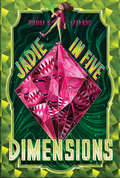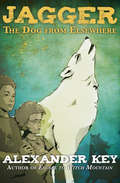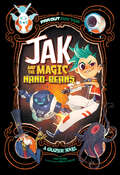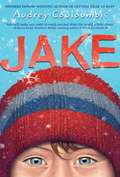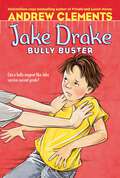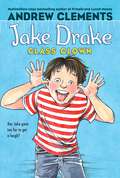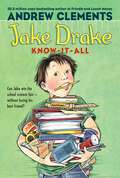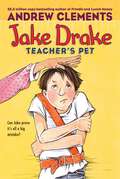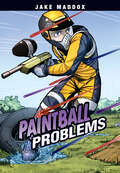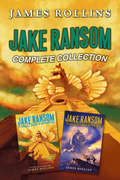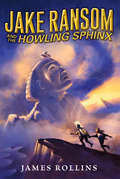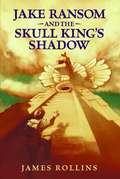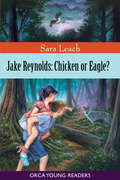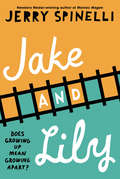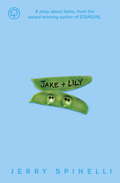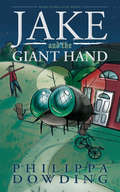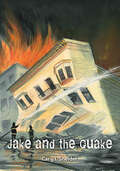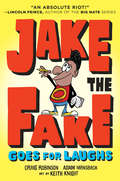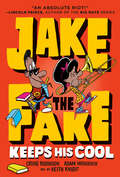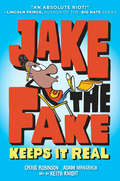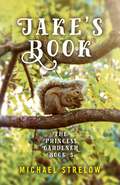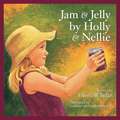- Table View
- List View
Jadie in Five Dimensions
by Dianne K. SalerniA thirteen-year-old girl seeks answers about her past in the fourth dimension—and beyond—in this think-outside-the-box adventure.What do you do when it turns out your whole life has been a lie? Jadie Martin was always told she was abandoned by her parents. Creatures from the 4th dimension rescued her and placed her with a loving adoptive family. Now, Jadie acts as an agent for the beings, also known as Seers. She uses the 4th dimension as a short-cut to travel anywhere on Earth, performing missions calculated to guide the world toward a brighter future.But then Jadie discovers that her origin story is fake. In reality, her birth family has suffered multiple tragedies and disasters engineered from 4-space, including the devastating loss of their baby girl. Her! Doubting the Seers, Jadie starts anonymously observing her long-lost family. Why are they so important? What are the true intentions of the Seers? And what will all-powerful four-dimensional beings do to a rebellious human girl when they realize she's interfering with their plans? A Wrinkle in Time meets Flatland in this thrilling journey that challenges the meaning of family, loyalty, and our universe at large. A Junior Library Guild Gold Standard Selection
Jagger: The Dog from Elsewhere
by Alexander KeyA magical dog falls through a portal and finds himself in AlabamaJagger is a protector of the hunted—a great white dog who stands between the people of his village and the evils that lurk outside of it. When an earthquake splits open the ground beneath his feet, Jagger travels through space to a mysterious forest, where a deer is running for her life. To save her, he fights off a pack of vicious hounds and gets shot in the leg by a pair of hunters. As he lies bleeding in the woods, running out of hope, he cries out with his mind—and a young girl&’s voice answers. Nan Thornberry has always had the ability to talk to animals, but she has never met one like Jagger. She and her older brother rescue the dog and bandage his wound. In return, he will serve as their protector, guarding them against the greatest evil he has ever had to face.
Jaime Escalante: A Man Who Made a Difference (Rigby Literacy by Design)
by Darleen RamosNIMAC-sourced textbook
Jak and the Magic Nano-Beans: A Graphic Novel (Far Out Fairy Tales Ser.)
by Carl Bowenstrongly written characters; giants; robots; classic fairy tale reworked with a modern undead twist; retelling of popular Jack and the magic beanstalk; fairy tale; magic beans; science fiction
Jake
by Audrey CouloumbisIt's a few days before Christmas when 10-year-old Jake's mom slips and breaks her leg. For as long as Jake can remember, it's just been him and his mom, so with no one else to look after him the hospital contacts the gruff granddad Jake only knows through awkward twice-a-year phone calls. When grandad shows up, he's nothing like Jake expected. But as Jake gets to know his grandfather and a makeshift family of friends and neighbors come together around him and his mom, he realizes that this might not be such a bad Christmas after all. <p><p> With beautiful spare writing that will appeal to fans of Because of Winn-Dixie and The Higher Power of Lucky, Newbery Honor—winning author Audrey Couloumbis tells a story as warm and welcome as a cup of hot chocolate on a cold day and shows that the best gift of all is the gift of family.
Jake Drake, Bully Buster (Jake Drake #1)
by Andrew Clements Amanda HarveyJake recounts his second grade introduction to Link Baxter, SuperBully, who becomes his class project partner, with surprising results.When Jake was three years old at Miss Lulu's Dainty Diaper Day Care Center, what did he know about bullies? Nothing. But he learned fast! Why? Because Jake was kind of smart and not a tattletale, and he had no big brother to protect him. He was a perfect bully magnet. But everything changed the year Jake was in second grade. That's when SuperBully Link Baxter moved to town. Jake had his hands full just trying to survive, until class project time. Who did the teacher assign to be Link's partner? You guessed it. Jake has to use all his smarts -- and his heart as well -- to turn himself from Jake Drake, Bully Magnet, to Jake Drake, Bully Buster.
Jake Drake, Class Clown (Jake Drake #4)
by Andrew Clements Dolores AvendañoKnock, knock. Who's there? Jake. Jake who? Jake Drake, Class Clown.Miss Bruce is the new student teacher in second grade, and she never smiles. Never. But when Jake cracks up the class during a spelling bee, he sees the tiniest hint of a smile at the corner of her mouth. Suddenly, Jake has a new mission in life: to be so funny that even Miss Bruce will laugh! But then things get out of hand, and Jake finds himself in big trouble. Has Jake discovered -- too late -- that not everybody loves a clown?
Jake Drake, Know-It-All (Jake Drake #2)
by Andrew Clements Dolores AvendañoJake's desire to win the school science fair almost costs him his best friend.Jake Drake is excited about Despres Elementary School's first science fair. He wants to win the grand prize: a brand-new Hyper-Cross-Functional Bluntium Twelve computer system. And he really wants to beat the third-grade know-it-alls, Marsha McCall and Kevin Young. The trouble is, to beat the know-it-alls, Jake has to become a know-it-all himself. And he may just lose more than he wins.
Jake Drake, Teacher's Pet (Jake Drake #3)
by Andrew Clements Dolores AvendañoThe end of third grade turns into a disaster for Jake when he inadvertently becomes the teacher's pet, and no matter how hard he tries, he can't shake the image.Mrs. Snavin looked right past all those waving hands. She looked right at me and she smiled and said, "I think I'll have Jake take it." Then Mrs. Snavin said, "but be sure to hurry right back, Jake, because we're going to work on our number-line project, and you have to be my special computer helper, okay?" And I could feel every kid in the class looking at me. They weren't saying anything. They weren't even whispering. But right then, I heard what they were thinking anyway. They were thinking, teacher's pet.
Jake Gaither, Winning Coach
by Wyatt BlassingameHe always did his best. This is an inspiring biography of a man who worked hard, excelled at sports, and survived brain cancer.
Jake Maddox: Paintball Problems (Jake Maddox Sports Stories Ser.)
by Jake MaddoxMax is excited for the end of the school year; not only will he get a break from Alex, the school bully, but he'll also get to spend the summer playing paintball. But when Alex joins the paintball league too,Êthings go from bad to worse. The bully has Max firmly in his sights, and Max has to find a solution for his paintball problems before it's too late.
Jake Ransom Complete Collection
by James RollinsBestselling novelist James Rollins brings to life the adventures of Jake Ransom, who became an orphan when his archaeologist parents disappeared on a dig three years ago. They left behind tokens--half of an ancient coin for Jake, and the other half for his sister Kady--that fit perfectly into one of their famous discoveries. When everything falls into place, Jake and Kady find themselves in the mysterious, bizarre world of Pangea--home of vicious raptors, bloodthirsty plants, and dark Mayan and Egyptian rituals. And whatever caught their parents is still hungry.The books described as "Indiana Jones for tweens" are perfect for fans of Alex Rider, Percy Jackson, and National Treasure. Includes Jake Ransom and the Skull King's Shadow and Jake Ransom and the Howling Sphinx.
Jake Ransom and the Howling Sphinx
by James RollinsUsing his father's watch as a key, Jake intends to return to Calypsos. Instead he's thrust into a strange desert land where he's joined by his friends Marika, Pindor, and Bach'uuk and his sister, Kady. As they try to figure out what to do next, a surprise attack by the beautiful young Princess Nefertiti takes them all captive.Soon even she is battling the Skull King's minions. For Jake has something the Skull King wants--a prize that will give its owner awesome power, including control of the fearsome Howling Sphinx. In a new pounding adventure, Jake races against time to outfight and outwit Kalverum Rex, knowing that if the Skull King wins, he'll be unstoppable.Filled with unexpected danger, challenging puzzles, and dazzling action, this is a first-rate, fast-paced thriller--a read only James Rollins could have created!
Jake Ransom and the Howling Sphinx
by James RollinsUsing his father's watch as a key, Jake intends to return to Calypsos. Instead he's thrust into a strange desert land where he's joined by his friends Marika, Pindor, and Bach'uuk and his sister, Kady. As they try to figure out what to do next, a surprise attack by the beautiful young Princess Nefertiti takes them all captive.Soon even she is battling the Skull King's minions. For Jake has something the Skull King wants--a prize that will give its owner awesome power, including control of the fearsome Howling Sphinx. In a new pounding adventure, Jake races against time to outfight and outwit Kalverum Rex, knowing that if the Skull King wins, he'll be unstoppable.Filled with unexpected danger, challenging puzzles, and dazzling action, this is a first-rate, fast-paced thriller--a read only James Rollins could have created!
Jake Ransom and the Skull King's Shadow
by James RollinsWhen a mysterious envelope arrives for Jake Ransom, he and his older sister, Kady, are plunged into a gripping chain of events. An artifact found by their parents--on the expedition from which they never returned--leads Jake and Kady to a strange world inhabited by a peculiar mix of long-lost civilizations, a world that may hold the key to their parents' disappearance.But even as they enter the gate to this extraordinary place, savage grackyls soar across the sky, diving to attack. Jake's new friends, the pretty Mayan girl Marika and the Roman Pindor, say the grackyls were created by an evil alchemist--the Skull King. And as Jake struggles to find a way home, it becomes obvious that what the Skull King wants most is Jake and Kady--dead or alive.
Jake Reynolds: Chicken or Eagle? (Orca Young Readers)
by Sara LeachEleven-year-old Jake Reynolds wants to save seal pups from the talons of bald eagles, protect his little sister Sierra and confront the wolf he is sure stalks Hidalgo Island. But his best friend Emily calls him a chicken, comforts Sierra when she falls and doesn't believe the wolf exists. Even as Jake hears howling in the night, part of him hopes Emily is right; he may dream of being a hero, but he is terrified by the thought of running into a wolf. When Jake leads Emily into the woods in search of adventure, he finds more than he bargained for—and discovers things about himself that he never knew existed.
Jake and Lily
by Jerry SpinelliThis is a story about me, Lily. And me, Jake. We're twins and we're exactly alike. Not exactly! Whatever. This is a book we wrote about the summer we turned eleven and Jake ditched me. Please. I just started hanging out with some guys in the neighborhood. Right. So anyway, this is a book about goobers and supergoobers bullies clubhouses true friends things getting built and wrecked and rebuilt and about figuring out who we are. We wrote this together (sort of) so you'll get to see both sides of our story. But you'll probably agree with my side. You always have to have the last word, don't you? Yes!
Jake and Lily
by Jerry SpinelliFor almost as long as they can remember, Jake and Lily have shared a "special sense". But their bond seems to be weakening as, at age 11, Jake starts spending more time with new friends than with Lily; upset and rejected, Lily has no one to confide in except her grandfather. Lily tries to find out who she is without her brother, but it's hard work. Her feeling of abandonment is as sharply felt as Jake's need to test his independence. Spinelli celebrates each child's individualism and growing self-awareness.
Jake and the Giant Hand
by Philippa DowdingThe first in a series of scary tall tales from award-winning children’s novelist Philippa Dowding. Why is Grandpa acting so weird? And why are there so many giant flies? Jake spends every summer on his grandpa’s farm. But this year, things are a little weird. First, there are huge flies everywhere. Second, Grandpa is acting kind of funny. And third, Jake’s friend Kate keeps trying to scare him with creepy stories. Last year’s tale about the swamp creature was bad enough, but this year’s story about a hand that someone found in a farmer’s field is even worse. And it wasn’t just any hand either. It was a giant’s hand! It might just be the creepiest story of all. It can’t be real. Can it?
Jake and the Quake
by Cary SneiderWhen Jake finds an unusual rock in the cliffs under the Golden Gate bridge, he embarks on an adventure of discovery that will bring him new friends, new knowledge, and even the confidence to face a devastating earthquake.
Jake the Fake Goes for Laughs (Jake the Fake #2)
by Adam Mansbach Craig RobinsonFor fans of Diary of a Wimpy Kid and Big Nate comes the second book in the side-splitting series about a class clown faking his way to comedy stardom from comedian and film star Craig Robinson, #1 New York Times bestselling author Adam Mansbach, and NAACP History Maker recipient and cartoonist Keith Knight."An absolute riot!" --LINCOLN PEIRCE, author of the BIG NATE seriesJake cracks up the crowd as a budding comedian at the Music and Art Academy talent show, but his new ego is no laughing matter. And when he starts blowing off his friends to pursue his "art," Jake's big head becomes a huge bummer.Plus, being the funny man is way tougher than it looks. Luckily, Jake has his mentor Maury Kovalski, a retired comedy showstopper, to teach him the ropes about humor--and humility--before Jake loses all his biggest fans and best friends!Featuring more than 200 illustrations, Jake the Fake stuns again with even greater gags and giggles than before!
Jake the Fake Keeps His Cool (Jake the Fake #3)
by Adam Mansbach Craig RobinsonFor fans of Diary of a Wimpy Kid and Big Nate comes the third book in this laugh-out-loud series about a class clown faking his way through middle school from comedian and film star Craig Robinson, #1 New York Times bestselling author Adam Mansbach, and NAACP History Maker recipient and cartoonist Keith Knight. <p><p> Life couldn't be better for Jake. He's a student at Music and Arts Academy and a budding comedian, and he finally put an end to his fake-ster ways . . . or so he thought. There's a new girl at school, and Jake would do anything to impress her, even pretending to be a master chef. And a world-renowned barber? <p><p> But at home, Jake is less impressed with his mom's news: she's pregnant. Now Jake has to fake being happy about becoming the Middle Child. The King of Cool is about to drop his chill. <p><p> Luckily, he has good friends and laughs on his side, along with more than two hundred illustrations--all about him!
Jake the Fake Keeps it Real (Jake the Fake #1)
by Adam Mansbach Keith Knight Craig RobinsonFor fans of Diary of a Wimpy Kid and Big Nate comes a new side-splitting series from comedian and film star Craig Robinson, #1 New York Times bestselling author Adam Mansbach, and NAACP History Maker recipient and cartoonist Keith Knight. Jake can barely play an instrument, not even a kazoo. And his art? It’s better suited for Pictionary than Picasso. Which is a real problem because Jake just faked his way into the Music and Art Academy for the gifted and talented (and Jake is pretty sure he is neither). More jokester than composer, Jake will have to think of something quick before the last laugh is on him. Featuring more than 160 illustrations, Jake the Fake is sure to bring the laughs with his hilarious high jinks!
Jake's Book: Book III of The Princess Gardener Series
by Michael StrelowJake's sisters have been important to the health and welfare of the kingdom. Jake has been on the outside looking in on their adventures in The Princess Gardener, and The Alyssa Chronicle. But now it's his turn. He's been watching from high in the trees, and now with a little help from some magical old friends, Jake finds transformation and the natural world as easy as the quick shake of a squirrel's tail. Jake's Book is volume III of The Princess Gardener series.
Jam and Jelly by Holly and Nellie
by Gloria WhelanHolly's family lives a simple life in northern Michigan, enjoying the bounty of the earth and very much in step with the rhythm of the changing seasons. But times are hard and a cold winter is coming. Without a warm coat, Holly might not be able to start school. Readers will delight in Mama's solution to Holly's predicament.
